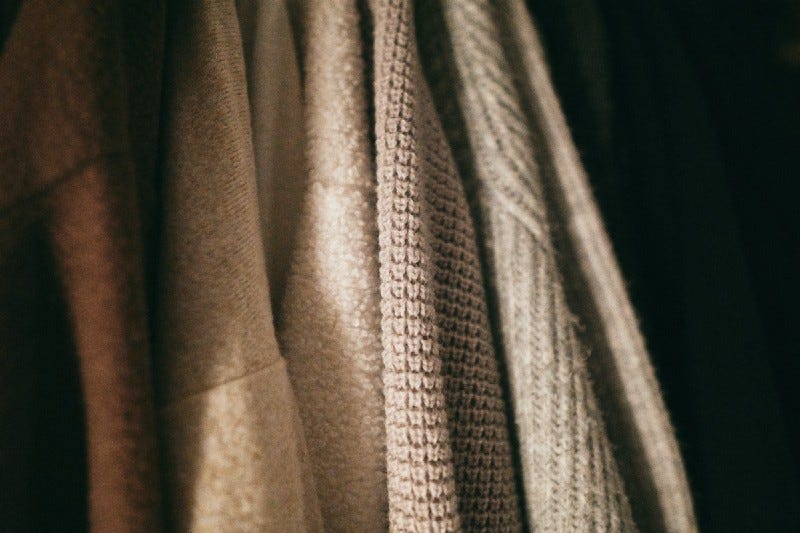Ideas are like sweaters.
In the fast and immediate product world we live in, everything seems produced and obvious; everything seems superficially contained and…

In the fast and immediate product world we live in, everything seems produced and obvious; everything seems superficially contained and finalized: “It’s there, and it exists, so I’ll wear it.”
This feeling of certainty leads us to violently neglect the deep and complex threads of interaction and creation that span a conclusion, an idea, a product, or a sweater.
Recently, there was the plagiarism of Póvoa do Varzim’s traditional Portuguese hand-knitted wool sweaters by a North American fashion designer. Copying the traditional knitted pattern in her “new collection,” selling them as originals in her store. But, in reality, what seems to be just a sweater is something quite complex.
Let’s see: we have wool, which has its cycle and flow. It is born and grows out of the sheep’s body. Each animal has its family and its life experience of being born, growing, and dying in a particular landscape, in a specific place, going through the bad weather and changing seasons, ruminating, jumping, and always herding. The quality of its fur and wool will depend on its diet, how it is treated, and its whole experience and relationship to life. Each sweater contains all the dimensions and interactions of each sheep. After the wool is sheared, it has to be washed, dyed, carded, and spun. Millennial manual labor processes, now industrial, lend to the yarn all the history of the hands that touch and transform it. Only then is the thread ready to be woven, expressing patterns. And the designs depend on everything that shapes the place, people, beliefs, and myths. The pattern that appears in the “poveiras” sweaters is not a chance, but an immanent expression of the whole context, from the hands that make them to the hearts that weave them to the stories they tell. In this case, each woman, with her experience of this traditional art, lends to each stitch a bit of herself, linking the origin of the meadows that feed the sheep to the identity of the place by recreating the patterns that emerge in each sweater.
When we feel appropriation by someone who simplifies and reduces a practice, a knowledge, a product, or an idea to something that simply “exists and therefore can be (appropriated and) used,” we observe a violent act of objectification, a disengagement from the very dynamic and living complexity of things. We feel it in the body, and not just in the ego, but in the soul.
I am often confronted with plagiarism using my words, processes, and conclusions. This is not about owning something, but a matter of life and responsibility. The ideas, feelings, opinions, and findings that I present in classes, articles, or books were not in sight, ready to be harvested and expressed. They were sown, watered, nurtured, lost and recovered, composted, tested, and experimented on. In a profound process as tearing as it is delicate, of presence and listening, in a challenging journey into the depths of things. Although they seem simple or obvious, they are born from my life process, my doubts and questions, my joys and sorrows, and the humility of not knowing the availability of getting lost to find my way again and again.
The ideas and perspectives that I present are alive and immanent to my concrete context and are, of course, limited to my experience, belifs, perspectives, and bias. During these dozens of years of entering the stream of consciousness and retrieving (always metamorphosing) pieces of the path, I am often confronted by the simplified copy (and without references) of conclusions that took me years — on a journey in and out full of mishaps from steep descents to arduous ascents — to systematize, complete and express.
Like the complexity of a sweater that is the embodiment of multidimensional and archaic history, that expresses the profound relationships between the meadows and the seasons, the ancestral movements and tools of spinning, the stories of each animal, person, and place, in a woven pattern, so the ideas are also alive—revealing (and hiding) themselves along the way, one step at a time.
Of course, we all have been inspired by other places and people who express them. My inspirations, as I mention so often, are many, including: Bayo Akomolafe, Nora Bateson, Pegi Eyers, Tyson Yunkaporta, David Abram, Laura Sewall, Vanessa Andreotti, Jürgen W. Kremer, Nick Totton, Thomas Berry, Mary Watkins, Charles Eisenstein, Chris Robertson, Robin Wall Kimmerer, and Bill Plotkin. And many others.
On my website, I have the following words: “All content on this site has been created, organized, and structured based on personal practice and experience. When using expressions or phrases, please cite the source. Thank you!”
Copyright is not a matter of ownership or control but a way to honor those who have walked the path before us, and even different or parallel paths. A way to express gratitude for the complexity of the challenges experienced, for what was previously cleared and rescued, and that brings us meaning where we are. We cannot forget that we all walk on the backs of our nameless ancestors. Who, by their life, manifested us, with their unique voice still echoing in each of us.




